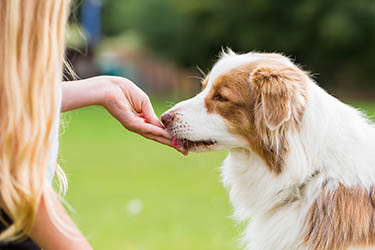Pet friendly behavior techniques

Pet-friendly techniques for animal handling and behavior modification
Throughout your career, you’ve likely encountered stressed-out pet owners who pass that anxiety and fear onto their pets. Like humans, animals can exhibit excessive, irrational fears and phobias. In fact, there are several types of phobias including: specific, animal, natural environment, blood-injection-injury and situational.
Clients may ask for your insight into behavior modification options for their pets, or you may need to utilize those same techniques for animals in your care. Which methods of correction and reinforcement are best?
The most efficient technique will certainly depend on the animal’s personality and history. Have they suffered abuse or neglect? Are they highly anxious? Are they aggressive when fearful?
Behavior modification techniques
The Merck Veterinary Manual identifies the following behavior modification techniques:
- Habituation is defined as repeated or prolonged exposure to a situation that results in the ending of or decreases in a response. No rewards are involved.
- Spontaneous recovery refers to the recovery of an action that was previously halted through habituation. The best method to discourage spontaneous recovery is to ignore the behavior.
- Conditioning refers to associations between stimuli and behavior and can be positive or negative.
- Reinforcement is an event that increases the chance that a behavior will reoccur. It can be positive or negative. Negative reinforcement is simply something unpleasant that can increase a behavior, like holding a dog tightly until they calm down.
- Second-order reinforcers are signals used at a distance to alert a dog that a reward is coming. Hand signals, clickers and vocal cues work well.
- Extinction is a response that stops when a reward is taken away. A classic example is to stop petting a dog when it jumps on people for attention.
- Overlearning refers to the repeated performance of an already learned behavior. It is mostly commonly used for event training and preventing fearful responses in dogs.
- Shaping requires rewarding a dog through gradual approximations. It works well for dogs that do not know what response is desired for reward.
- Desensitization requires careful exposure to a situation in order to teach a dog to be tolerant of that situation.
- Counterconditioning is replacing an unwanted behavior with a more favorable one. It generally follows desensitization and requires relaxation.
- Flooding requires prolonged exposure to a stimulus. The ultimate goal is to stop unwanted responses to stimuli by increased exposure.
- Punishment is the most commonly used form of behavior modification involving an unfavorable reaction to unwanted behavior.
- Premack Principle is a theory stating, “that more likely behaviors will reinforce less likely behaviors.” When misbehaving helps a dog achieve a goal, it is more likely that the dog will misbehave.
- Response substitution involves the replacement of unfavorable behavior with favorable behavior. It generally begins with desensitization.
Positive reinforcement training
Positive reinforcement is often the most preferred way to train a dog and involves three simple steps:
- Consistency is key.
- Keep commands short and simple.
- Reward immediately.
Positive reinforcement training is a great way to teach commands and shape and reinforce desired behavior. Remind your clients that while food and treats may work well as rewards, praise, petting and play work equally well and won’t lead to animals overeating or becoming overweight.
The American Kennel Club advises the use of a value system for your positive rewards. A “low-value” reward could be carrots, ice cubes, green beans or dry biscuits. These work best during training at home when distractions are fewer. A “medium-value” reward might be commercial training treats or meaty treats that work best when used in your yard. The “high-value” rewards are best for more public places and include premium chews and soft dog treats with flavors like peanut butter, salmon and chicken.
Low stress handling
Low Stress Handling is a behavioral medication method developed by Dr. Sophia Yin to reduce stress in animals. Dr. Yin was a veterinarian, animal behaviorist and internationally renowned expert on Low Stress Handling™. Her “pet-friendly” techniques for animal handling and behavior modification, many of which she developed herself through the scientific method of research and rigorous testing, are shaping the new standard of care for veterinary and animal care professionals. The technique is taught through a certification program offered for companion animal owners, animal care workers (including veterinary technicians, trainers, groomers and rescue workers) and veterinarians.
For pet owners, it involves training the pet to willingly accept medical treatment to create a more pleasant veterinary experience. The certification for veterinary technicians, trainers, groomers and rescue workers covers a variety of situations ranging from walking techniques to counter-conditioning for medical procedures. Beyond learning how to recognize fearful or anxious body language, Low Stress Handling teaches how to resolve the fear and anxiety.
From the veterinarian’s perspective, how you approach an animal can make all of the difference between an easy examination and a difficult one. Knowing how to handle stressed animals in a compassionate way also translates into a single-time visit versus a long-term client. Your example sets the tone for your staff, patients and pet owners.
Contact your Covetrus sales representative online or at 855.724.3461 for help in practice data analysis and identifying resources to increase patient compliance and enhance the bottom line of your practice.
Sources
https://www.psychologytoday.com/us/blog/dog-days/201612/canine-phobias
https://www.merckvetmanual.com/dog-owners/behavior-of-dogs/behavior-modification-in-dogs
http://www.humanesociety.org/animals/dogs/tips/dog_training_positive_reinforcement.html
https://lowstresshandling.com/low-stress-handling/what-is-low-stress-handling/
Careers
Are you looking for a place to let your talents shine? At Covetrus, we help our practitioner customers better serve their patients and take pride in providing the best customer experience possible. Search our open positions to see our available opportunities.
Newsletter
Stay current with what’s going on with Covetrus, subscribe to receive our newsletter and email communications. Subscribers will receive the latest information in practice management, sales and marketing, animal health, and more.


Leave a comment